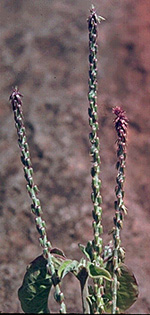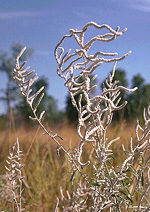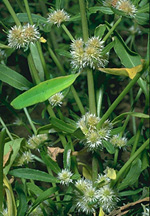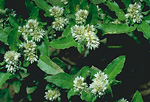 |
This large family is almost cosmopolitan, mostly in warm, dry regions. In Australia, species of Amaranthaceae are most common in the arid zone and the wet-dry tropics but some may be found in almost any habitat except the high alps, heathlands and mangroves. Many species, especially in the east and north, are weedy, some being troublesome agricultural pests. The large genera Ptilotus and Gomphrena are important in central and northern Australia.
Characteristic features of the family Amaranthaceae in Australia include: - shrubs or herbs (usually more or less woody) with opposite leaves
- flowers in spikes (sometimes head-like) or axillary clusters, with a one-whorled, usually dry and papery perianth
- anther filaments often fused into a cup, with extra filiform processes between the stamens
- ovary superior, usually developing into a capsule dehiscing by a transverse (circumscissile) split, rarely into a fleshy berry
Description
Evergreen shrubs, or annual, biennial or perennial terrestrial herbs; rarely woody or herbaceous scrambling vines or aquatic herbs rooted in the substrate with their leaves emergent. If herbs then perennating by taproots or crowns. Stem unarmed or rarely with spines arising from the leaf axils; internodes terete or distinctly angular. Internal secretions not obvious. Plants glabrous, or with simple or dendritic, non-glandular, unicellular or uniseriate hairs. Leaves alternate and spiral or opposite, cauline or both basal and cauline if herbs, petiolate, subsessile or sessile. Stipules absent. Lamina simple, symmetric, filiform, acicular, subulate, linear, lanceolate, ovate, elliptic, rhombic, oblanceolate, obovate, oblong, spathulate or orbicular; base cuneate or attenuate; margins entire or rarely sinuate, ±flat; one-veined, or the venation pinnate, with the midrib conspicuous, and the tertiary venation reticulate or not; surfaces not punctate; herbaceous, leathery or succulent. Male and female flowers occurring on the same plant or on separate plants, or male and bisexual flowers occurring on separate plants, or with all the flowers bisexual. Inflorescences terminal or axillary, consisting of glomerules, spikes, racemes or panicles. Bracts and bracteoles present. Pollination by insects, wind or possibly small mammals. Flowers odourless or rarely fragrant; sessile or stalked. Floral disc present; nectaries absent, or present on the ?stamens. Perianth regular, of 1 whorl only, free, with 3–5, free, tepaloid segments, imbricate in bud, green, white, cream, yellow, orange, red, pink, magenta, purple or violet, without contrasting markings, herbaceous, papery or membranous. Fertile stamens 2–5, opposite to and free or at least partly fused to perianth segments, free of ovary and style, distinct from each other or fused by their filaments into an open or closed tube, all ±equal. Staminodes and pseudostaminodes present or absent. Anthers dorsifixed, versatile, opening outwards by longitudinal slits; 1–2-celled. Ovary superior and sessile or stalked. Carpels 2–3 (–4), fused and appearing as 1; ovary with 1 locule. Style terminal or rarely eccentric, single and unbranched or branched above or from the base. Ovules 1 or 4–20, stalked; placentation basal. Fruit dry or fleshy, dehiscent or indehiscent; a circumscissile capsule, utricle or berry; the perianth on the maturing fruit persistent. Disseminule macro-surface featureless or with straight or crimped hairs or with spines; micro-surface ±smooth, papillate or reticulate, white, cream, yellow, orange, red, pink, magenta, purple, violet, green, brown, grey or black, glossy or not. Seeds 1 or 4–20 per fruit. Aril absent. Cotyledons 2. Embryo curved.
(Note: this description has been generated from the coded data compiled for the key. Any errors in the key data will be reflected in the descriptions.)
A treatment of the family Amaranthaceae has not yet been published in the Flora of Australia. It will appear in Volume 5.
Australian genera of Amaranthaceae (as recognised for the Flora of Australia)
† = some species native, others introduced
* = all species introduced
*Aerva
†Alternanthera
†Amaranthus
*Celosia
Cyathula
Deeringia
Froelichia
Gomphrena
*Guilleminea
Hemichroa
Nyssanthes
Omegandra
Ptilotus
*Pupalia

|
  |

Achyranthes aspera (flowers and fruit)
Photo: F.Humphreys © ANBG

Aerva javanica (flowering plant)
Photo: M.Fagg © M.Fagg

Alternanthera denticulata (flowers)
Photo: B.Fuhrer © B.Fuhrer

Alternanthera nana (flowers)
Photo: B.Fuhrer © B.Fuhrer

|

| |